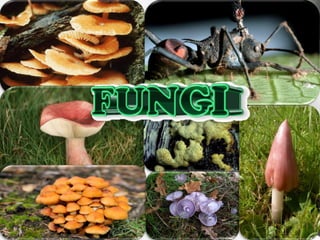Fungi
•Transferir como PPT, PDF•
2 gostaram•2,854 visualizações
Denunciar
Compartilhar
Denunciar
Compartilhar

Recomendados
Recomendados
Mais conteúdo relacionado
Mais procurados
Mais procurados (20)
Destaque
Destaque (20)
Beneficial and harmful effect of microorganisms Sarah

Beneficial and harmful effect of microorganisms Sarah
Semelhante a Fungi
Semelhante a Fungi (20)
6 chap 8 (kingdom fungi) f.sc 1st year biology helping notes

6 chap 8 (kingdom fungi) f.sc 1st year biology helping notes
Último
This presentation was provided by William Mattingly of the Smithsonian Institution, during the third segment of the NISO training series "AI & Prompt Design." Session Three: Beginning Conversations, was held on April 18, 2024.Mattingly "AI & Prompt Design: The Basics of Prompt Design"

Mattingly "AI & Prompt Design: The Basics of Prompt Design"National Information Standards Organization (NISO)
Último (20)
A Critique of the Proposed National Education Policy Reform

A Critique of the Proposed National Education Policy Reform
BAG TECHNIQUE Bag technique-a tool making use of public health bag through wh...

BAG TECHNIQUE Bag technique-a tool making use of public health bag through wh...
Web & Social Media Analytics Previous Year Question Paper.pdf

Web & Social Media Analytics Previous Year Question Paper.pdf
Beyond the EU: DORA and NIS 2 Directive's Global Impact

Beyond the EU: DORA and NIS 2 Directive's Global Impact
Z Score,T Score, Percential Rank and Box Plot Graph

Z Score,T Score, Percential Rank and Box Plot Graph
Mattingly "AI & Prompt Design: The Basics of Prompt Design"

Mattingly "AI & Prompt Design: The Basics of Prompt Design"
Kisan Call Centre - To harness potential of ICT in Agriculture by answer farm...

Kisan Call Centre - To harness potential of ICT in Agriculture by answer farm...
social pharmacy d-pharm 1st year by Pragati K. Mahajan

social pharmacy d-pharm 1st year by Pragati K. Mahajan
Measures of Central Tendency: Mean, Median and Mode

Measures of Central Tendency: Mean, Median and Mode
Call Girls in Dwarka Mor Delhi Contact Us 9654467111

Call Girls in Dwarka Mor Delhi Contact Us 9654467111
Measures of Dispersion and Variability: Range, QD, AD and SD

Measures of Dispersion and Variability: Range, QD, AD and SD
Fungi
- 2. These are heterotrophic eukaryotic organisms. They use decaying organic material as food and are therefore called saprophytes. Many of them have the capacity to become multicellular organisms at certain stages in their lives. They have cell-walls made of a tough complex sugar called chitin. Examples are Yeast and Mushrooms.
- 3. Filaments of fungi are called hyphae. The cell walls contain chitin. The MYCELIUM is a mat of hyphae visible to the unaided eye (bread mold) Some hyphae may divided by cross sections called septa
- 5. Fungi reproduce in both ways, 1) Sexually and, 2) Asexually Asexual Reproduction- production of various types of spores Sporangiophores- upright stalk with an enclosed sac ( bread mold) Conidia - upright stalk with no enclosed sac (penicillin) Fragmentation – hyphae dry out and shatter releasing individual cells that act like spores (athlete’s foot).
- 6. Budding – small offspring. Sexual Reproduction “plus and minus” mating types Hyphae of different mating types fuse and give rise to a specialized structure that produces spores ( diploid) Most fungi are haploid throughout most of their life cycle. When environmental conditions are favorable, asexual reproduction occurs rapidly. When unfavorable conditions stress the organism, sexual reproduction occurs and the offspring have an increased like hood that they will be better suited for the environment.
- 8. • They are called Saprophytes, they act as recyclers of dead organic matter, obtaining food from this material. • Hyphal tips release enzymes that eventually decompose and release organic materials into the surrounding environment. • Saprophytic fungi appear on dead trees, logs, plant litter such as leaves, and even dead insects and animals. Examples: "Gem-studded Puffball" (Lycoperdon perlatum) and "Turkey Tail"(Trametes versicolor).
- 9. • Fungi are important decomposers of dead animal and plant matter. They break down dead organic matter into simple compounds that can be absorbed by the plants around it. During the process of decomposing matter, fungi returns carbon dioxide to the atmosphere. Green plants use the carbon dioxide during photosynthesis to produce food.
- 10. • Beneficial Effects of Fungi * Decomposition - nutrient and carbon recycling. * Biosynthetic factories. Can be used to produce drugs, antibiotics, alcohol, acids, food (e.g., fermented products, mushrooms). * Model organisms for biochemical and genetic studies. • Harmful Effects of Fungi * Destruction of food, lumber, paper, and cloth. * Animal and human diseases, including allergies. * Toxins produced by poisonous mushrooms and within food (e.g., grain, cheese, etc.). * Plant diseases.
- 11. Fungal diseases are called mycoses and those affecting humans can be divided into four groups based on the level of penetration into the body tissues: Superficial mycoses are caused by fungi that grow on the surface of the skin or hair. Cutaneous mycoses or dermatomycoses include such infections as athlete's foot and ringworm, where growth occurs only in the superficial layers of skin, nails, or hair. Subcutaneous mycoses penetrate below the skin to involve the subcutaneous, connective, and bone tissue. Systemic or deep mycoses are able to infect internal organs and become widely disseminated throughout the body.
- 14. V.VAMSI KRISHNA Class : IX Roll No : 919